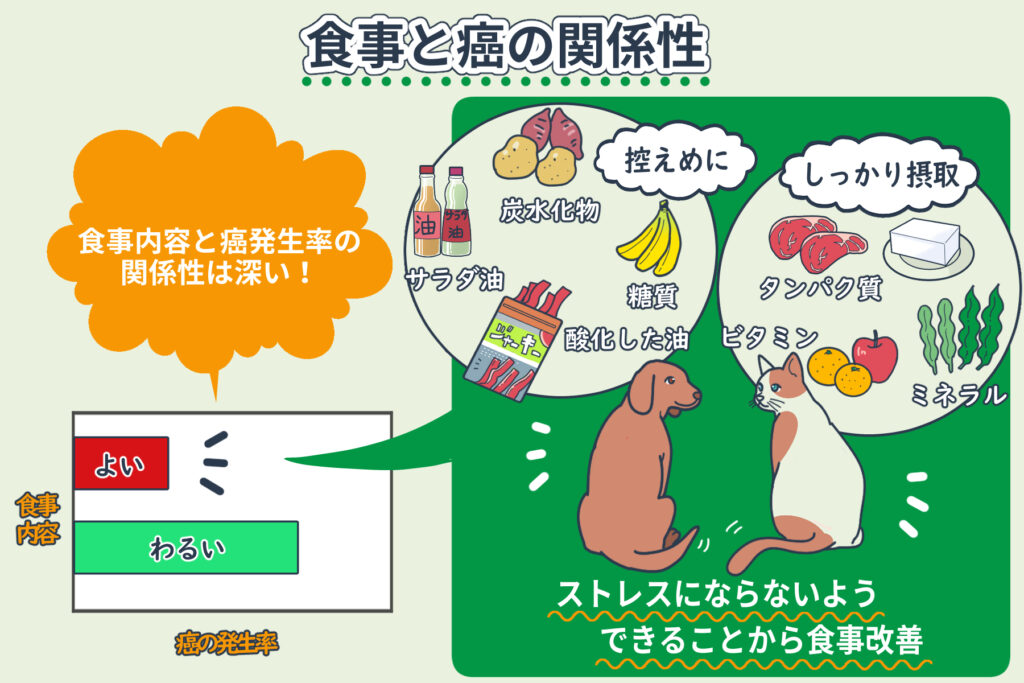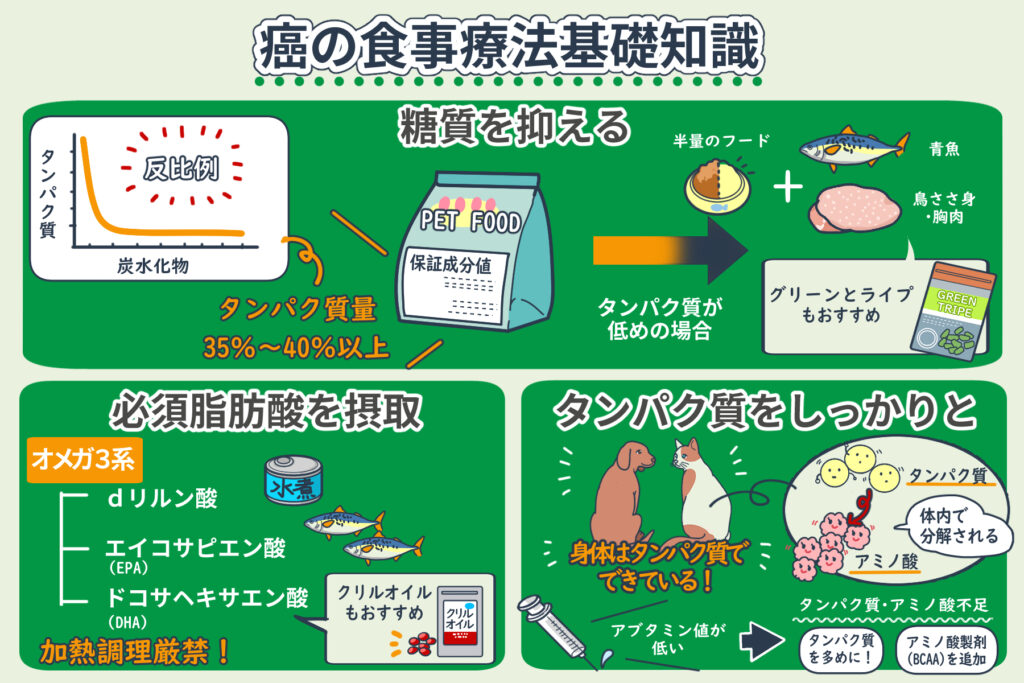When dogs, cats, or other pets are diagnosed with cancer, the first thing we would like everyone to try is dietary therapy.
It is difficult to cure cancer solely by changing the diet, but at the very least, it can help slow down the growth of cancer and curb its progression.
Additionally, implementing immune system support can significantly increase the chances of maintaining quality of life (QOL) without putting stress on the body.
目次
The Relationship Between Diet and Cancer

There is a deep connection between the incidence of cancer and the content of the diet.
Sometimes it is said that “it is better to take in a lot of calories to build the energy to fight cancer,” but it is not simply a matter of consuming more calories.
Whether for dogs, cats, or humans, we should avoid diets high in sugars and carbohydrates or poor-quality fats.
For example, you can understand that “the incidence of cancer differs between people who eat a lot of junk food and those who eat fresh vegetables and meals prepared with high-quality oils.”
Providing a well-balanced diet and improving the living environment can reduce the chances of your beloved dogs or cats developing cancer, and even if they already have cancer, it can contribute positively to their prognosis.
We encourage pet owners to review their pets’ diets and living environments to the extent that is manageable.
Start With What You Can Do
While you cannot directly apply human dietary therapies to dogs and cats, there are many common elements that can be referenced.
Furthermore, the basic knowledge of a cancer-preventative diet will surely benefit the health of the owners as well.
- Limit carbohydrates (sugars).
- Ensure adequate protein intake.
- Avoid oxidized oils (limit treats like jerky).
- Do not overconsume vegetable oils (omega-6 oils are not healthy oils).
- Be mindful of vitamin and mineral intake.
- Change the diet at a pace that does not cause stress to the pet or the owner.
Basic Knowledge of Cancer Dietary Therapy

Limit Glucose, A Nutrient Source for Cancer
Tumor cells only take in and grow by using the glucose found in carbohydrates as their sole source of nutrition.
In other words, if you can control the amount of carbohydrates in food, it may be possible to inhibit the growth of tumors.
Generally, foods high in grains tend to be rich in sugars, so caution is necessary.
The main nutrients found in food are protein, carbohydrates, and fats.
Guaranteed analysis values for protein and fat are typically listed on the packaging.
However, according to Japanese law, there is no requirement to indicate the carbohydrate or sugar content on pet food labels, so most manufacturers do not list these values.
So, how can we choose foods low in carbohydrates and sugars?
The answer is simple, we recommend foods with protein content of 35% to 40% or higher.
Foods high in protein generally have lower carbohydrate content.
There is an inverse relationship between protein and carbohydrate content, so a high-protein diet equates to a low-carbohydrate diet.
▼Example of Dog Food from Company A
- Crude Protein: 21.0% or more
- Crude Fat: 10.5% or more
- Crude Fiber: 4.0% or less
- Ash: 8.0% or less
- Moisture: 10.0% or less
↓↓↓
Carbohydrates (%) = 46.5%
※100 − (21 + 10.5 + 4.0 + 8.0 + 10)
Example of Dog Food from Company B
- Crude Protein: 35% or more
- Crude Fat: 11% or more
- Crude Fiber: 8.0% or less
- Ash: 7% or less
- Moisture: 12% or less
↓↓↓
Carbohydrates (%) = 27%
※100 − (35 + 11 + 8 + 7 + 12)
Considering that dogs are omnivores leaning towards carnivores, which is reflected in their intestinal length and dental structure,
is considered preferable.
Taking this into account, choosing food with a high protein content is deemed
“suitable for both a dog’s dietary needs and as a diet against tumors.”
Pick a few foods that interest you and check their guaranteed nutrient values before making a selection.
Alternatively, just by adding toppings such as green tripe (the stomach of ruminant animals), the protein content in the meal increases, which subsequently reduces the carbohydrate content.
- Dietary Therapy for Cancer in Dogs and Cats – High Protein, Low Carbohydrate
- New Dietary Ideas to Combat Cancer (for Dogs and Cats)
- Proactively Taking Vitamins for Cancer Prevention in Dogs and Cats
- About Low-Protein Diet for Cats with Renal Disease
- Supplementing BCAAs for Dogs and Cats with Fatigue, Liver, or Kidney Problems
Proactively Provide Essential Fatty Acids
Of course, these fats are also necessary for dogs and cats.
A deficiency can lead to poor health and decreased immune function.
Fatty acids are essentially oils.
In pet food, they are listed as lipids (mostly as saturated fatty acids, though).
Lipids are high in calories and often regarded merely as an energy source, but they play crucial roles in maintaining health.
Omega-3 Essential Fatty Acids
Alpha-linolenic acid, eicosapentaenoic acid (EPA), and docosahexaenoic acid (DHA) are types of lipids known as omega-3 fatty acids, which are expected to have anti-inflammatory and blood circulation-improving effects.
Especially, DHA is known to affect the brain and retinal nerves, making it a key component in the prevention of dementia and the alleviation of symptoms like dry eye.
While fish oil is rich in EPA and DHA, krill oil derived from Antarctic krill (a type of zooplankton) contains EPA and DHA in a phospholipid-bound form, making it more soluble in water and easier for the body to absorb.
EPA and DHA can be beneficial in cancer treatment and are recommended when there’s a concern about inflammatory conditions such as atopic dermatitis, pneumonia, stomatitis, or nephritis.
However, avoid using omega-3 oils for cooking as they are highly susceptible to oxidation.
Essential Omega-6 Fatty Acids
Linoleic acid, alpha-linolenic acid, and arachidonic acid are examples of omega-6 fatty acids. While essential for the body, their overconsumption can pose issues, and it’s crucial to balance them with omega-3 fatty acids.
These can induce inflammation and exacerbate conditions like cancer and atopic dermatitis, so caution is advised.
Despite being labeled as healthy oils, it’s recommended to minimize the use of vegetable oils, as they are not necessarily good for health.
Provide Plenty of Protein
For dogs and cats, protein is crucial to their physical health.
Organs, muscles, blood vessels, and the brain are all composed of protein, as are vital substances such as hormones and enzymes.
Proteins are broken down into amino acids in the body and absorbed into the system.
Proteins (amino acids) are constantly re-synthesized in the body and distributed throughout.
However, they are not entirely recycled; some are excreted in urine. Hence, it is imperative to replenish proteins (amino acids) through daily meals.
If the dietary protein is insufficient, the body will break down muscle to produce amino acids.
During blood tests at the veterinary hospital, make sure to check albumin (ALB) levels. It can predict whether your pet is getting enough protein.
Extremely low albumin levels indicate a deficiency in protein/amino acids.
If albumin levels are low despite a proper diet, consider increasing the dietary protein or adding amino acid supplements.
When it is difficult to provide sufficient protein through their diet, adding pure amino acids can help maintain muscle mass.
Supplements like BCAAs (valine, leucine, isoleucine), which help in reducing muscle protein breakdown and muscle synthesis, and serve as an energy source during exercise, are available for convenient supplementation.
Consider adding BCAAs to regular meals when protein intake is low.
We have also compiled an article about what constitutes a low-carbohydrate, high-protein diet for your reference.
- Dietary Therapy for Cancer in Dogs and Cats – High Protein, Low Carbohydrate
- New Dietary Ideas to Combat Cancer (Dogs and Cats Edition)
- Actively Supplementing with Vitamins for Cancer Prevention in Dogs and Cats
- Low Protein Diet for Cats with Kidney Disease
- Supplementing BCAA for Dogs and Cats with Fatigue or Liver and Kidney Issues
Dietary Therapy and Immune Measures
At Cordy Laboratory, we are conducting research on the effects of Cordy on immunity and its preventive effects on dogs and cats with cancer.
We believe that combining dietary therapy with this can yield better results and are advancing our research accordingly.
If you have any questions, please contact us.
監修獣医師:林美彩 所属クリニック:chicoどうぶつ診療所

代替療法と西洋医学、両方の動物病院での勤務経験と多数のコルディの臨床経験をもつ。 モノリス在籍時には、一般的な動物医療(西洋医学)だけでは対応が困難な症例に対して多くの相談を受け、免疫の大切さを痛烈に実感する。
ペットたちの健康維持・改善のためには薬に頼った対処療法だけではなく、「普段の生活環境や食事を見直し、自宅でさまざまなケアを取り入れることで免疫力を維持し、病気にならない体づくりを目指していくことが大切である」という考えを提唱し普及活動に従事している。
所属:






